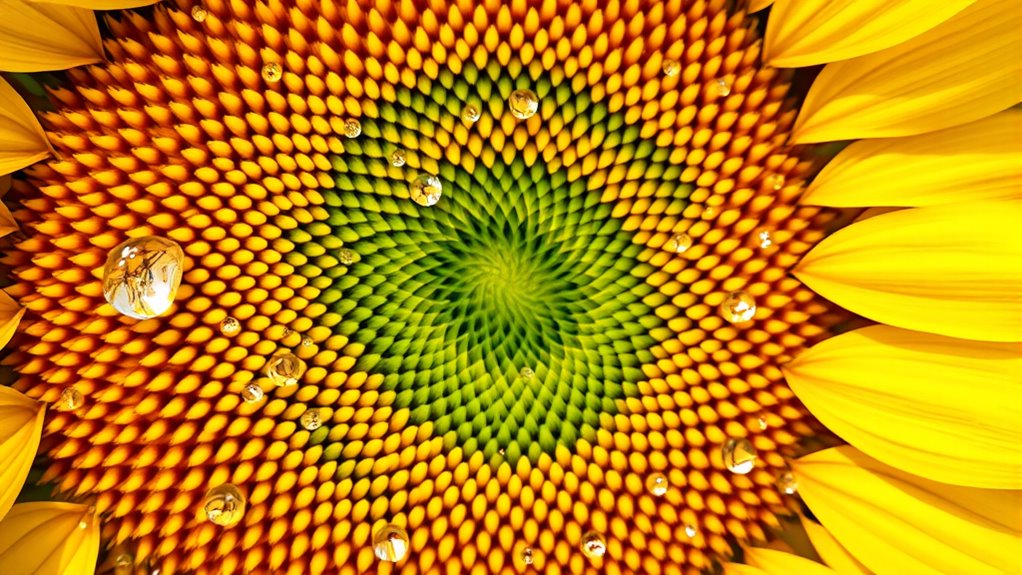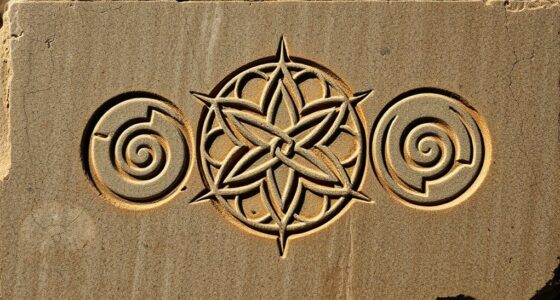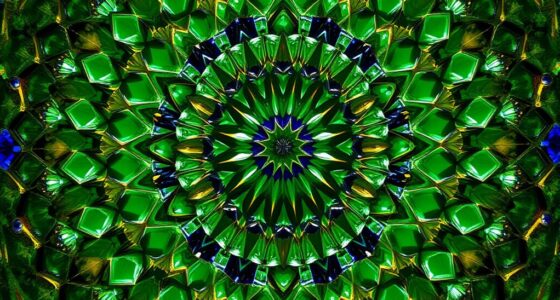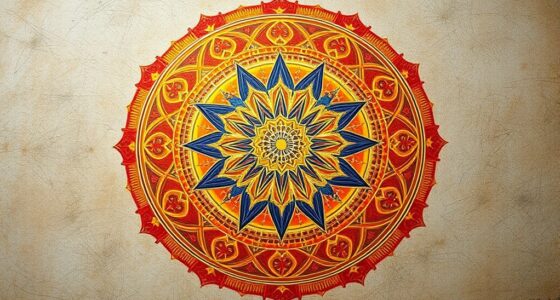The Golden Ratio, approximately 1.618, is a universal code found in nature, art, and architecture that creates harmony and balance. You can see it in sunflower spirals, seashells, and even the Parthenon. This ratio is connected to the Fibonacci sequence, which explains its natural occurrence. Recognizing these patterns reveals how the universe is structured with beauty and order. Continue exploring to uncover even more secrets behind this fascinating mathematical harmony.
Key Takeaways
- The Golden Ratio (~1.618) appears naturally in shells, flowers, galaxies, and other biological structures.
- Recognizing the ratio in nature reveals underlying patterns of harmony and growth.
- Understanding its mathematical properties, like Fibonacci sequence links, helps unlock its universal presence.
- Artists and architects historically used the ratio to create aesthetically pleasing designs.
- Appreciating the Golden Ratio enhances perception of balance and order in the natural and human-made world.

Have you ever wondered why certain designs and shapes seem naturally pleasing to the eye? The answer lies in a fascinating mathematical principle called the Golden Ratio. This ratio, approximately 1.618, appears in countless aspects of nature, art, and architecture, resonating with our innate sense of beauty. To truly understand its allure, you need to explore its mathematical significance and historical origins. The Golden Ratio isn’t just a random coincidence; it’s a concept rooted in mathematics that has fascinated thinkers for centuries. Its mathematical significance lies in its unique properties—any rectangle with sides in this ratio can be subdivided into a square and a smaller rectangle with the same proportions. This recursive property creates an infinite sequence, known as the Fibonacci sequence, where each number is the sum of the two preceding ones. The ratio between consecutive Fibonacci numbers approaches the Golden Ratio as the numbers grow larger, illustrating an intrinsic connection between this sequence and the ratio’s beauty. Recognizing how mathematical properties underpin this ratio can deepen your appreciation for its presence in the world around us.
Tracing back to its historical origins, the Golden Ratio can be found in ancient civilizations that recognized its aesthetic power. The Greeks, especially, employed it in their architecture and art, aiming for harmony and balance. The Parthenon is often cited as an example, with its proportions believed to embody this divine ratio. The ancient Egyptians also utilized proportions that align with the Golden Ratio in their pyramids and temples, although the term itself wasn’t used until much later. During the Renaissance, artists like Leonardo da Vinci studied and applied the ratio extensively, believing it embodied the divine beauty of the universe. The term “Golden Ratio” was coined in the 19th century, but the concept’s roots stretch back thousands of years, across different cultures and civilizations. Its historical origins reveal a universal recognition of this ratio’s power to create harmony, whether in the proportions of a building or the composition of a painting.
Understanding the mathematical significance and historical origins of the Golden Ratio helps you appreciate why it appears so frequently in nature and human creations. It’s no coincidence that seashells, sunflower heads, and galaxy spirals all exhibit proportions close to this divine ratio. Recognizing this pattern allows you to see the world through a lens that highlights harmony and balance. The Golden Ratio isn’t just an abstract mathematical idea; it’s a timeless code woven into the fabric of the universe, guiding the way nature and humans craft beauty. When you grasp its origins and relevance, you’ll likely begin noticing this extraordinary ratio everywhere, revealing a hidden order that underpins the seemingly chaotic world around you.
Frequently Asked Questions
How Is the Golden Ratio Used in Modern Architecture?
You see the golden ratio in modern architecture when designers use it to create aesthetic harmony. It’s inspired by ancient buildings like the Parthenon, which used this ratio to achieve balance and beauty. Architects incorporate it into building proportions, layouts, and facades to evoke a sense of natural harmony. By applying this timeless principle, they craft structures that feel visually pleasing and well-balanced, blending ancient wisdom with contemporary design.
Can the Golden Ratio Be Applied to Digital Design?
Imagine a subtle harmony guiding your digital designs, making them feel more balanced and appealing. Yes, you can apply the golden ratio to digital design, blending fractal patterns and color harmony to create visually enchanting layouts. This natural proportion helps evoke emotions, making your work resonate more deeply with viewers. By embracing these principles, you craft digital experiences that feel intuitive, elegant, and effortlessly engaging, transforming ordinary into extraordinary.
Are There Any Health Benefits Associated With the Golden Ratio?
You might wonder if the golden ratio offers health benefits. While it’s primarily known for aesthetics, some believe it promotes biological health by encouraging balanced growth and harmony in nature. Though direct scientific evidence is limited, the ratio can influence nutritional benefits by guiding natural food compositions and portioning. Embracing the golden ratio may subtly support overall well-being through more harmonious biological health and balanced nutrition.
How Does the Golden Ratio Influence Music Composition?
Imagine discovering a hidden secret in music composition. The golden ratio influences musical harmony by guiding sound proportions, creating naturally pleasing melodies. When you use this divine proportion, your music feels more balanced and enthralling. It subtly shapes rhythms, melodies, and harmonies, making the listening experience instinctively satisfying. The golden ratio isn’t just a visual marvel; it’s a powerful tool that can elevate your compositions to resonate deeply with your audience.
Is the Golden Ratio Visible in Everyday Objects?
You might notice the golden ratio in everyday objects like flower patterns and shell spirals. These natural forms often follow this mathematical principle, creating visually pleasing proportions. When you observe a sunflower’s seed arrangement or a nautilus shell, you see how the golden ratio shapes their structure. Recognizing these patterns helps you appreciate nature’s design, revealing its subtle yet profound influence on the world around you.
Conclusion
Now that you’ve uncovered the golden ratio’s presence in nature, it’s clear this divine proportion isn’t just a myth. Many scientists and mathematicians support its existence as a fundamental code that shapes our world, from galaxies to flowers. While some argue it’s a coincidence, the consistent appearance across diverse forms suggests there’s more to this pattern than mere chance. Embrace the idea that nature’s secret code might hold the key to understanding beauty and harmony in our universe.









